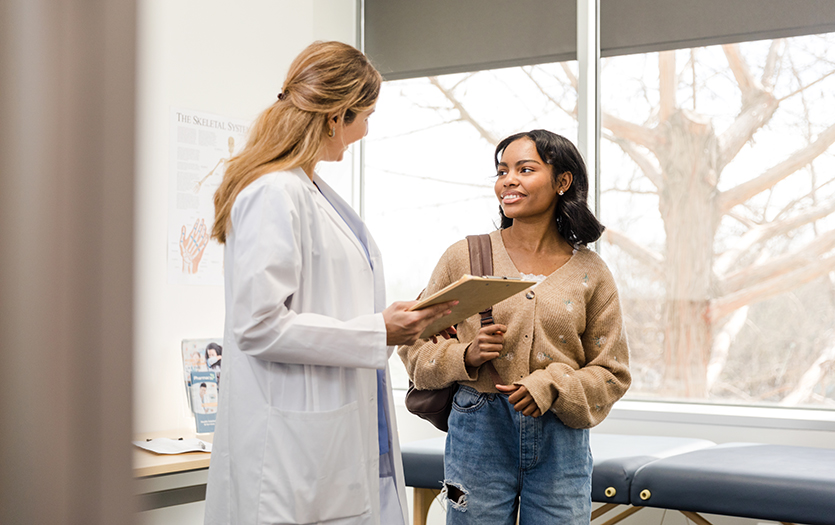
This post was written by Breck Hunnicutt, NP, Oncology: High Risk Team, Parkview Packnett Family Cancer Institute.
When it comes to cancer, there are controllable and uncontrollable risk factors. The uncontrollable risk factors are things that you have very little, if any, influence over. These can include family history of cancer, aging, inherited pathogenic gene variants, and certain medical conditions, such as diabetes, autoimmune diseases and exposure to certain chemicals, such as asbestos or radon.
For this post, I want to focus on the things we can control. Specifically, actionable measures you can take to potentially reduce your risk for developing cancer.
Controllable risk factors
While there is no proven way to prevent cancer, there are healthy choices and knowledge about cancer risk that can help. There is plenty of advice with many conflicting studies. The research is continuously looking for new ways to prevent cancer, but experts know that certain lifestyle choices can affect the chances of getting cancer.
1. Don't use tobacco or vape and avoid secondhand smoke.
-
Cancers linked to smoking include lung, mouth, throat, voice box, pancreas, bladder, cervix and kidney. Secondhand smoke may raise the risk of lung cancer.
-
Chewing tobacco has been linked to cancer of the mouth, throat and pancreas.
-
Vaping may also increase the risk of lung cancer, even if it does not include nicotine, due to other chemicals, which may be present.
-
Smoking cessation is recommended for cancer risk reduction.
-
A healthcare provider can prescribe medication and products to assist.
-
There are smoking cessation groups and online smoking cessation support.
-
2. Eat healthy foods.
Eating healthy foods might lower the risk of cancer and lends to achieving or maintaining a healthy weight.
-
Focus on fruits, vegetables and other foods from plant sources, such as whole grains and beans. Limit foods high in calories, fats and added sugars. Limit red meat, processed meats, refined grains, and saturated and trans fats.
-
It is best to avoid alcohol, however if you choose to drink, it’s best in moderation (1-3 drinks a week). Alcohol raises the risk of various types of cancer, including cancer of the breast, colon, lung, kidney and liver. The risk goes up the more you drink.
-
A Mediterranean diet may lower risk of breast cancer. The Mediterranean diet focuses mostly on plant-based foods, such as fruits and vegetables, whole grains, legumes and nuts. People who follow the Mediterranean diet choose healthy fats, such as olive oil, rather than butter. And they eat fish or chicken instead of red meat.
3. Stay at a healthy weight and be physically active.
Being at a healthy weight may lower the risk of some types of cancer, including breast, pancreas, liver, colon and kidney.
-
BMI goal is 18.5 kg/m2 to 24.9 kg/m2, in general. This can vary among different body builds.
-
Any physical activity is good; however, the goal is at least 150 minutes of moderate activity or 75 minutes of vigorous aerobic activity a week.
-
Generally, 30 minutes a day, five days a week is a goal; however, any daily activity is beneficial.
4. Protect yourself from the sun.
Skin cancer is one of the most common kinds of cancer and one of the easiest to prevent. Practice sun safety by following these tips:
-
Limit time spent in the sun. Avoid midday sun (10 a.m. - 4 p.m.) when the sun's rays are strongest.
-
When outdoors, be in the shade and use sunglasses and a broad-brimmed hats.
-
Wear clothing that covers the skin and utilize SPF clothing.
-
Use plenty of sunscreen with an SPF of at least 30, even on cloudy days. Apply it generously and re-apply every 2 hours or more if swimming.
-
Don't use tanning beds or sunlamps. These can do as much harm as sunlight.
5. Get vaccinated.
Protecting yourself against certain viral infections can help prevent some cancers.
-
Hepatitis B can raise the risk of liver cancer.
-
Human papillomavirus (HPV) is a primary cause of cervical, head and neck, and anal cancer and can also be associated with penile, vulvar and vaginal cancer. An old HPV infection can re-surface at an older age.
6. Stay away from risky behaviors.
Some behaviors carry a high risk of infections that can raise the risk of getting cancer. To help prevent cancer:
-
Practice safe sex. Limit the number sexual partners and use a condom.
-
Don't share needles. Using drugs with shared needles can lead to HIV, which can lead to hepatitis B and hepatitis C, which can raise the risk of liver cancer. If you need help with drug misuse or addiction, please reach out to a healthcare provider or a substance abuse facility, either locally or nationally.
7. Get regular medical care and cancer screenings.
There are a number of national cancer screenings, which are usually covered by insurance. Check with your healthcare provider if you may need more or different screenings based on family, genetics or personal history.
-
Breast cancer: Annual mammogram starting at age 40 with a clinical breast exam. Self-breast awareness can be utilized at all ages.
-
Colon cancer: Colonoscopy at age 45, then every 10 years if no abnormalities are found. If a colonoscopy is not feasible, a home stool DNA (mt-sDNA) may be utilized starting at age 45 then every 3 years.
-
Cervical cancer: Obtain a PAP smear every 3 years from age 21-29 and every 5 years from age 30-65, as well as an HPV test. Frequency of pelvic exams may be discussed with a healthcare provider.
-
Lung cancer: Recommended for tobacco use of 20 pack years, which is calculated by multiplying the number of years smoked by the number of packs a day. If that calculation equals 20 or more, a low dose CT scan of the lung may be obtained on an annual basis.
-
Prostate cancer: Screening may be based on family history and can be discussed with a healthcare provider. A PSA with or without a digital rectal exam at ages 45-75 may be recommended with frequency dependent on the testing results. Black/African American’s may start at age 40 due to the increased risk of prostate cancer in this population.
-
Skin cancer: Self skin awareness is recommended, following up with a healthcare provider for a change of an existing mole, the development of a new pigmented or unusual-looking growth. Look for ABCDE of melanoma.
-
A is for asymmetrical.
-
B is for irregular boarders.
-
C is for changes in color.
-
D is for diameter.
-
E is for evolving change in size or continuing to change in any way.
-
-



